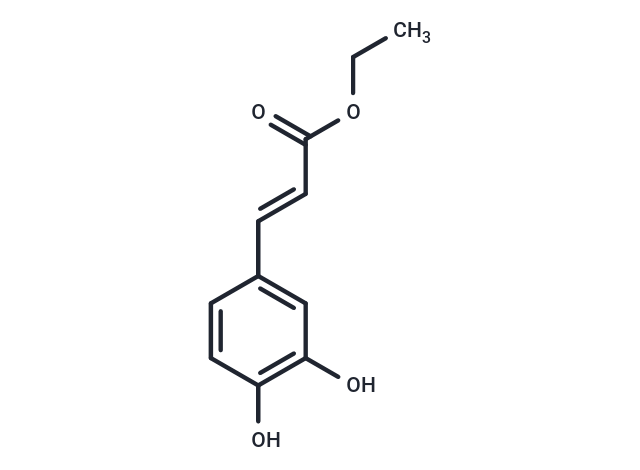 Your shopping cart is currently empty
Your shopping cart is currently empty

1. Ethyl trans-caffeate (Caffeic Acid Ethyl Ester) has anti-inflammatory activity. 2. Ethyl trans-caffeate may as a promising natural compound for future application in chronic liver disease. 3. Ethyl trans-caffeate is a potent chemopreventive compound against skin carcinogenesis caused by solar UV exposure. 4. Ethyl trans-caffeate is the high-resolution structures of representative inhibitors in complex with human pancreatic α-amylase. 5. Ethyl trans-caffeate strongly inhibits neoplastic transformation of JB6 Cl41 cells without toxicity. PI3K, ERK1/2, and p38 kinase activities were suppressed by direct binding with HOEC in vitro.

| Pack Size | Price | USA Warehouse | Global Warehouse | Quantity |
|---|---|---|---|---|
| 20 mg | $50 | Inquiry | Inquiry | |
| 50 mg | $78 | Inquiry | Inquiry | |
| 1 mL x 10 mM (in DMSO) | $50 | Inquiry | Inquiry |
| Description | 1. Ethyl trans-caffeate (Caffeic Acid Ethyl Ester) has anti-inflammatory activity. 2. Ethyl trans-caffeate may as a promising natural compound for future application in chronic liver disease. 3. Ethyl trans-caffeate is a potent chemopreventive compound against skin carcinogenesis caused by solar UV exposure. 4. Ethyl trans-caffeate is the high-resolution structures of representative inhibitors in complex with human pancreatic α-amylase. 5. Ethyl trans-caffeate strongly inhibits neoplastic transformation of JB6 Cl41 cells without toxicity. PI3K, ERK1/2, and p38 kinase activities were suppressed by direct binding with HOEC in vitro. |
| Synonyms | Ethyl caffeate, Caffeic Acid Ethyl Ester |
| Molecular Weight | 208.21 |
| Formula | C11H12O4 |
| Cas No. | 66648-50-8 |
| Smiles | C(=C/C(OCC)=O)\C1=CC(O)=C(O)C=C1 |
| Relative Density. | 1.271g/cm3 |
| Color | White |
| Appearance | solid |
| Storage | Powder: -20°C for 3 years | In solvent: -80°C for 1 year | Shipping with blue ice/Shipping at ambient temperature. | |||||||||||||||||||||||||||||||||||
| Solubility Information | DMSO: 50 mg/mL (240.14 mM), Sonication is recommended. | |||||||||||||||||||||||||||||||||||
Solution Preparation Table | ||||||||||||||||||||||||||||||||||||
DMSO
| ||||||||||||||||||||||||||||||||||||
| Size | Quantity | Unit Price | Amount | Operation |
|---|

Copyright © 2015-2025 TargetMol Chemicals Inc. All Rights Reserved.